| Since the smear tests were complete in my book at this point, I decided to use those strips for one final test. Seeing as how I've been soaking the strips in room-temperature water the entire time, I decided to see if a few extra degrees would have any effect on it. One measuring cup and a microwave (which is in dire need of cleaning... damn spots are hard to wash out), and I was set to give this thing the boiling of its life. Since the 'clean' side of the strips was all written on, I figured to use the 'printed' side for this test. It'll also give me a vague idea as to how well the printing holds up after being in boiling water. I boiled both of the strips for five minutes, and then tried to write on one of them. |
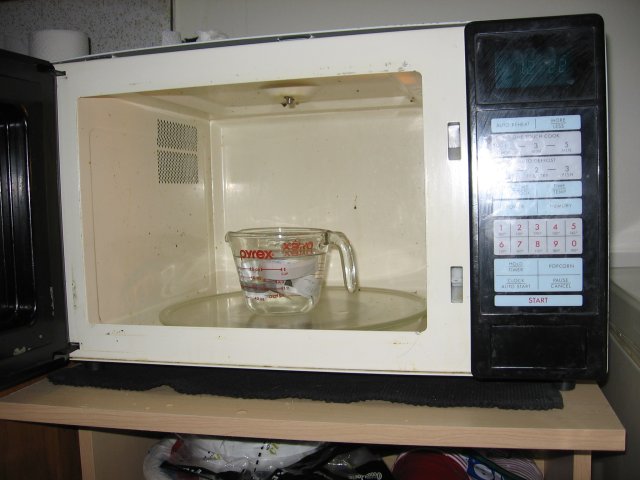 |
| Five minutes of vigorous boiling later (timed from when the water started to boil) and I pulled out the paper with a skewer. It wrote just as easily as if the water had been room-temperature. I gave it another 5 minutes of boiling and took it out for the last time. Yet again, it wrote the exact same as previous. Some of the ink from the 5-minute strip had faded just slightly, but that's likely because I dropped it back into the water about 20 seconds after having written that. I didn't bother to show the opposite side of the strips, since all the ink there was completely identical to the images in the 'smear' test. Boiling seemed to have no effect on the paper in the slightest. |
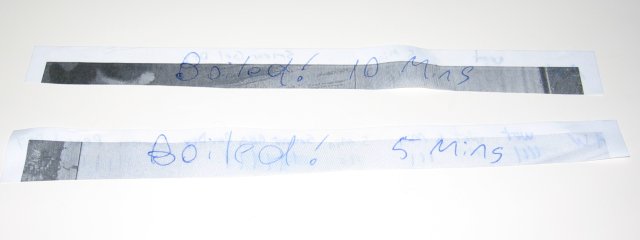
|
| Since hot water appears to have little to no effect on it, let's see how it handles cold water. I got a few rectangles of both regular paper and all-weather paper and once again wrote a pre-test example as a baseline. Unfortunately, given winter is over at the moment and it's just getting past spring and towards summer, I'm currently lacking the famous 'Winnipeg winter' of -50 degree celcius nights. Hence, our freezer will have to do. It's set to -6 degrees celcius (slightly colder than our standing fridge-freezer). Should I sometime gain access to liquid nitrogen or one of the -70 degree freezers at the University, I may try another test there, but don't hold your breath. |
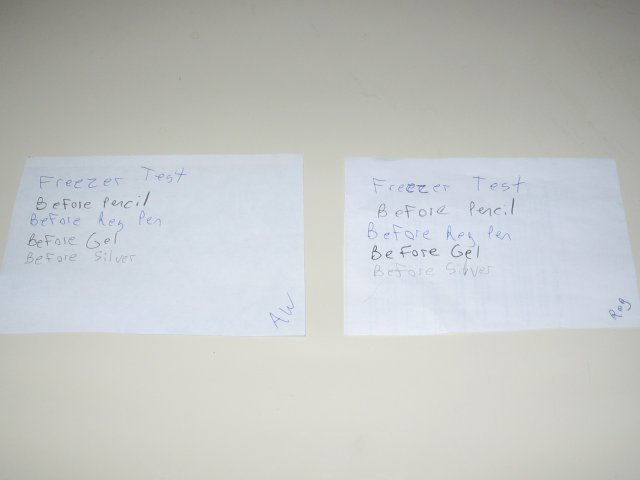 |
| I first froze the papers while dry. Both the all-weather and the regular paper were both cold to the touch and perhaps slightly more crinkly, but both took the writing of all pen types absolutely perfectly. It wasn't that easy to write on, either, since for these tests I was leaving the papers in the freezer and leaning inside to write on them. If I removed them from the freezer, they would likely warm up to room temperature in a matter of seconds. I needed to work with them when they were still below freezing. Since dry-freezing it did nothing whatsoever, I soaked each page for five minutes and THEN froze them. At least THAT should get a little more activity out of them. |
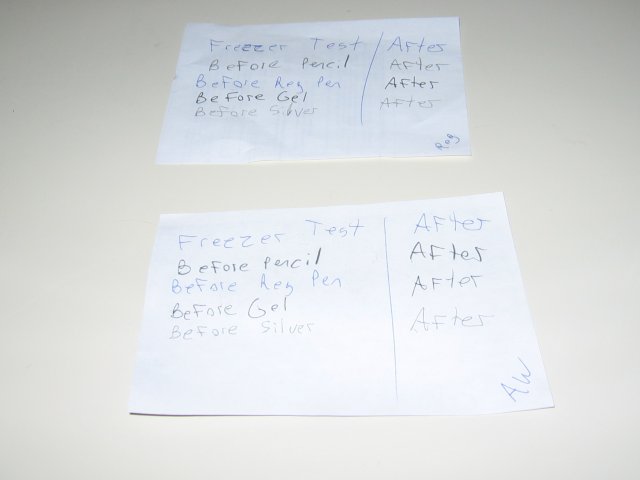 |
| After about an hour in the freezer, I poked at them... frozen solid. I was able to write on the all-weather paper just fine with pen and pencil. The gel pen bled a little bit when the tip of the pen ran into a frozen droplet of water. If the droplet didn't just break away from the paper like it usually did, it would melt almost instantly to the touch of the tip of the pen, thus giving the gel liquid water to run into. The silver pen didn't run at all, but took a little bit to get going, as can be seen by the "W". The regular paper refused virtually all writing from all pens, except the gel pen. That one attempted to write, but bled into the paper a fair bit. All other pens left only the slightest hint of ink/graphite/gel here and there, and was completely unreadable. Predictably, the previous ink wasn't affected at all. |
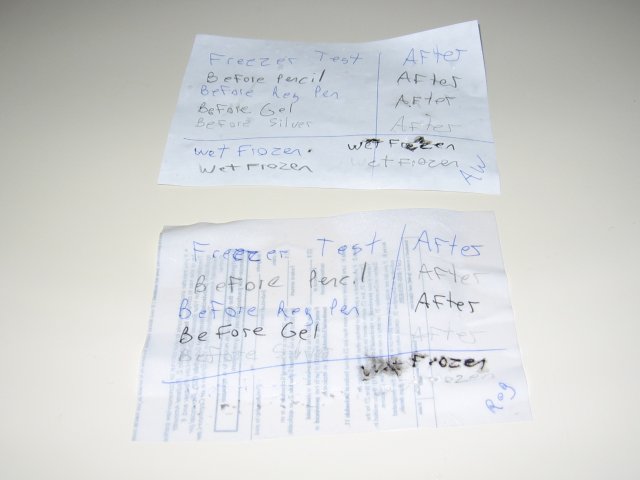
|
| And now that we've seen one end of the spectrum, let's take a look at the other. Since running through a dryer cycle (see the bottom of wetness test, part 2) did next to nothing, let's see what a few hundred more degrees could do. Fire! BURN, BURN!!! *ahem* Anyway, I had four strips of paper to work with... comparing the burn of regular paper to all-weather paper while dry, and then while wet. For each one, I held the tip of the paper to the flame of a candle just until it lit on fire. After exactly two seconds of holding it horozontally (as best I could with the wet papers, anyway), I put it onto the tin foil. The fire then went out on its own where the paper touched the foil. |
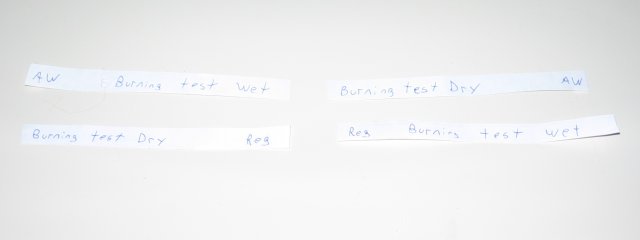 |
| First up we had regular paper while dry. It lit on fire easily, and burned as easily as paper. This wasn't really much of a 'test' per-se, as creating a baseline to which I can compare the all-weather paper. Unless you've lived at the bottom of a the ocean for your entire life, I'm sure we've all seen what paper looks like when it's on fire. |
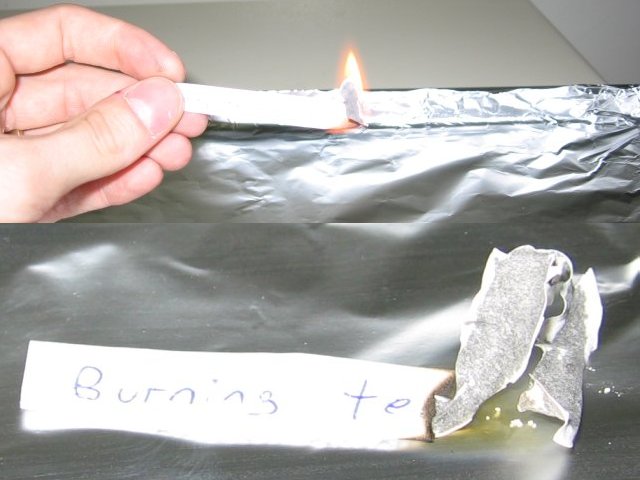
|
| THIS is the test I was most curious about. Does all-weather paper burn worse, or better than regular paper? Upon being lit up, the flame flared up at the very beginning quite high, and then settled down slightly for the remainder of the two seconds. The flame itself was probably about twice as high as with the regular paper. However, it burned through about the exact same length of the strip as with regular paper. This could perhaps be used as a better fire-starter, albeit a lot more expensive. |
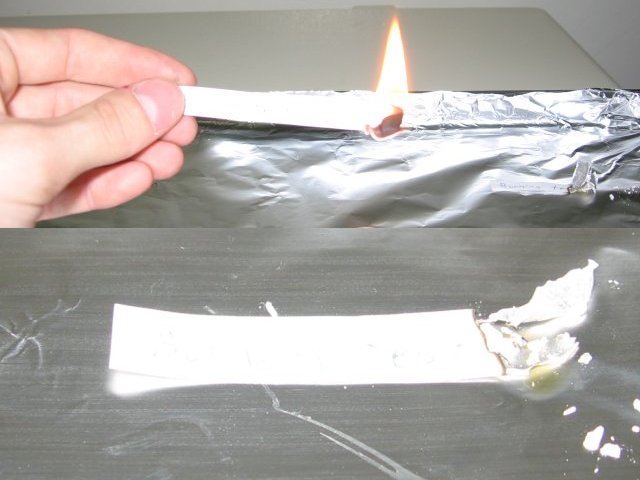 |
| Next up was the wet versions of this test. I only gave the strips about 5 seconds of soaking in the water before toweling what water I could off of it (to avoid drips that would put out the candle). The regular paper took about 10 seconds of constant flame to get the slightest bit of paper burning. The flame went out about 5 seconds after removing it from the candle. I wasn't able to hold it horozontally, but that clearly wouldn't have made any difference whatsoever. |
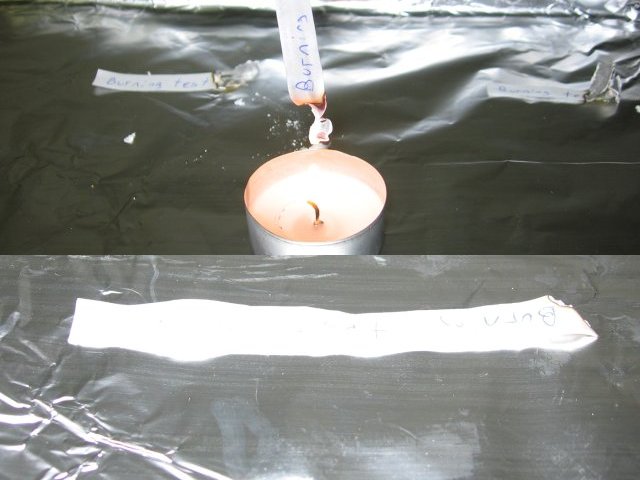
|
| The all-weather paper did a lot better however. It took about 3 seconds to light on fire, and didn't flare up at all like when it was dry. Holding it horozontally, it stubbornly continued to burn the very top edge of the paper strip. It seemed to be drying out the path it was taking. Had I held the paper downwards so the flame could lick straight up the strip, I'm certain it would have burned completely. I would suggest every camper have a few sheets of the paper hidden somewhere, as it seems that it would potentially be useful for starting a fire even when damp. |
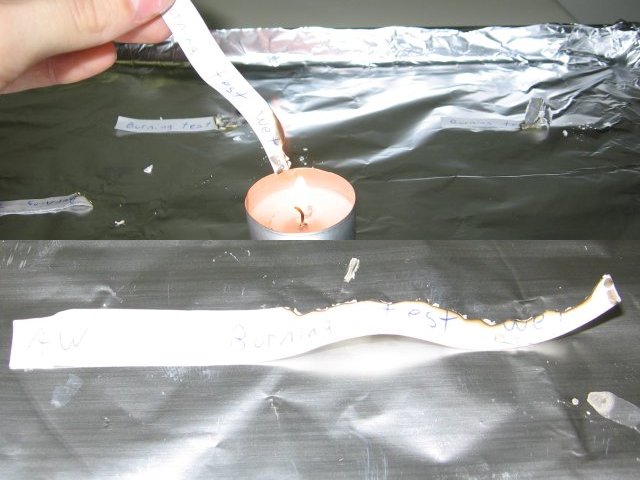
|
The crumple test | The multiple fluids test (part 1)
|
